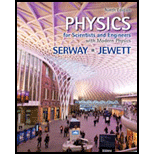
Concept explainers
(a)
The amplitude of the wave.
(a)
Answer to Problem 20P
The amplitude of the wave is
Explanation of Solution
The standard expression for the wave function of a wave is.
Here,
At
Write the expression of wave function at
The speed of the wave is obtained by taking the derivative of equation (I). the speed of the wave at
Substitute equation (I) in (II).
Write the expression for angular frequency in terms of time period.
Here,
The trigonometric identity
Multiply and divide the first term by
Substitute,
Conclusion:
Substitute,
Substitute,
Therefore, the amplitude of the wave is
(b)
The initial phase angle.
(b)
Answer to Problem 20P
The initial phase angle is
Explanation of Solution
Derive an expression for
Rewrite equation (VI) to obtain an expression for
Conclusion:
Substitute,
The value of
Therefore, the initial phase angle is
(c)
The maximum transverse speed of the elements in the string.
(c)
Answer to Problem 20P
The maximum transverse speed of the elements in the string is
Explanation of Solution
The transverse speed is already determined in part (a).
The maximum value of cosine is 1.
Thus, the expression for maximum transverse speed is.
Conclusion:
Substitute,
Therefore, the maximum transverse speed of the elements in the string is
(d)
The wave function of the wave.
(d)
Answer to Problem 20P
The wave function of the wave is
Explanation of Solution
Consider equation (I) which is the standard expression for wave function.
Write the expression for wavelength.
Here,
Write the expression for wave number.
Conclusion:
Substitute,
Substitute,
Substitute,
Therefore, the wave function of the wave is
Want to see more full solutions like this?
Chapter 16 Solutions
Physics for Scientists and Engineers With Modern Physics
- Pls help asaparrow_forwardPls help asaparrow_forward3. If the force of gravity stopped acting on the planets in our solar system, what would happen? a) They would spiral slowly towards the sun. b) They would continue in straight lines tangent to their orbits. c) They would continue to orbit the sun. d) They would fly straight away from the sun. e) They would spiral slowly away from the sun. 4. 1 The free-body diagram of a wagon being pulled along a horizontal surface is best represented by A F N B C 0 Ꭰ FN E a) A b) B c) C app app The app 10 app d) e) ס ח D E 10 apparrow_forward
- The acceleration of an object sliding along a frictionless ramp is inclined at an angle 0 is 9. a) g tano b) g cose c) g sino 10. d) g e) zero A 1.5 kg cart is pulled with a force of 7.3 N at an angle of 40° above the horizontal. If a kinetic friction force of 3.2 N acts against the motion, the cart's acceleration along the horizontal surface will be a) 5.0 m/s² b) 1.6 m/s² c) 2.4 m/s² 11. d) 1.0 m/s² e) 2.7 m/s² What is the net force acting on an object with a mass of 10 kg moving at a constant velocity of 10 m/s [North]? a) 100 N [North] b) 100 N [South] 10 N [North} d) 10 N [South] e) None of these.arrow_forwardModified True/False - indicate whether the sentence or statement is true or false. If the statement is false, correct the statement to make it true. 12. An object in uniform circular motion has a constant velocity while experiencing centripetal acceleration. 13. An object travelling in uniform circular motion experiences an outward centrifugal force that tends to pull the object out of the circular path. 14. An object with less inertia can resist changes in motion more than an object with more inertia. 15. For an object sliding on a horizontal surface with a horizontal applied force, the frictional force will always increase as the applied force increases.arrow_forwardPls help asaparrow_forward
 Physics for Scientists and Engineers: Foundations...PhysicsISBN:9781133939146Author:Katz, Debora M.Publisher:Cengage Learning
Physics for Scientists and Engineers: Foundations...PhysicsISBN:9781133939146Author:Katz, Debora M.Publisher:Cengage Learning University Physics Volume 1PhysicsISBN:9781938168277Author:William Moebs, Samuel J. Ling, Jeff SannyPublisher:OpenStax - Rice University
University Physics Volume 1PhysicsISBN:9781938168277Author:William Moebs, Samuel J. Ling, Jeff SannyPublisher:OpenStax - Rice University Principles of Physics: A Calculus-Based TextPhysicsISBN:9781133104261Author:Raymond A. Serway, John W. JewettPublisher:Cengage Learning
Principles of Physics: A Calculus-Based TextPhysicsISBN:9781133104261Author:Raymond A. Serway, John W. JewettPublisher:Cengage Learning Physics for Scientists and Engineers, Technology ...PhysicsISBN:9781305116399Author:Raymond A. Serway, John W. JewettPublisher:Cengage Learning
Physics for Scientists and Engineers, Technology ...PhysicsISBN:9781305116399Author:Raymond A. Serway, John W. JewettPublisher:Cengage Learning Physics for Scientists and EngineersPhysicsISBN:9781337553278Author:Raymond A. Serway, John W. JewettPublisher:Cengage Learning
Physics for Scientists and EngineersPhysicsISBN:9781337553278Author:Raymond A. Serway, John W. JewettPublisher:Cengage Learning Physics for Scientists and Engineers with Modern ...PhysicsISBN:9781337553292Author:Raymond A. Serway, John W. JewettPublisher:Cengage Learning
Physics for Scientists and Engineers with Modern ...PhysicsISBN:9781337553292Author:Raymond A. Serway, John W. JewettPublisher:Cengage Learning





